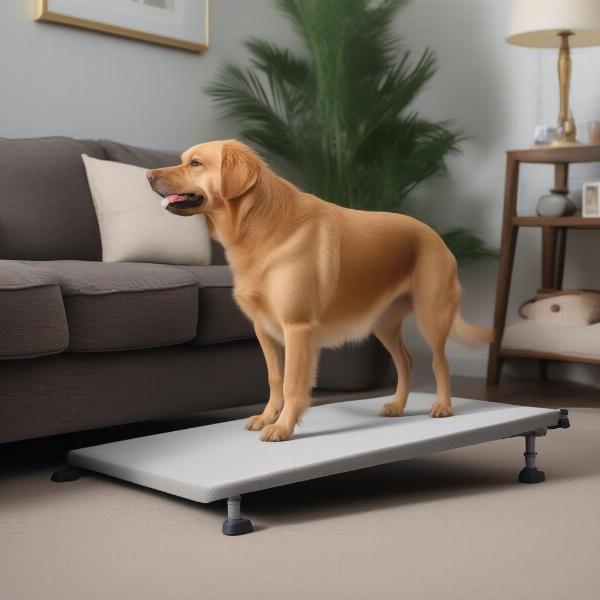Old age can bring various health challenges for our beloved canine companions, and weak back legs are a common concern among senior dogs. If you’re noticing your old dog struggling with their back legs, this guide provides practical advice and support to help you navigate this challenging time and ensure your furry friend remains comfortable and happy.
Understanding Weakness in Your Senior Dog’s Back Legs
Several factors can contribute to weakness in an older dog’s back legs, ranging from arthritis and hip dysplasia to degenerative myelopathy and even neurological issues. Identifying the underlying cause is crucial for effective management. Observe your dog closely for signs like difficulty standing, walking, climbing stairs, or even incontinence. Is your dog stumbling more? Are they slipping on the floor? These are all important clues to share with your veterinarian.
Veterinary Diagnosis and Treatment Options
A thorough veterinary examination is the first step in addressing your old dog’s weak back legs. Your veterinarian will likely conduct physical and neurological tests, possibly including blood work and X-rays, to pinpoint the cause of the weakness. Based on the diagnosis, treatment options may include medications for pain management, physical therapy, acupuncture, or even surgery in some cases.
“Early diagnosis is key,” says Dr. Emily Carter, DVM, a veterinary specialist in geriatric canine care. “The sooner we identify the cause of the weakness, the sooner we can implement a treatment plan to improve the dog’s quality of life.”
Home Care and Support for Your Senior Dog
Even with veterinary intervention, providing the right home environment is essential for supporting your old dog with weak back legs. Here are some key considerations:
- Provide a supportive and comfortable bed: Opt for orthopedic beds designed for senior dogs, providing extra cushioning and support for aching joints.
- Make your home accessible: Use ramps or steps to help your dog navigate stairs and furniture. Consider non-slip flooring or rugs to prevent slips and falls.
- Maintain a healthy weight: Excess weight puts extra strain on your dog’s joints. Work with your veterinarian to ensure your dog maintains a healthy weight through a balanced diet and appropriate exercise.
- Gentle exercise: While strenuous activity should be avoided, regular, gentle exercise is still important for maintaining muscle strength and joint mobility. Short walks, swimming, or even gentle stretches can be beneficial. Consult with your veterinarian or a canine rehabilitation specialist to develop an appropriate exercise plan.
 Senior dog using a ramp
Senior dog using a ramp
Nutrition and Supplements
A balanced diet is crucial for your senior dog’s overall health, and certain nutrients can play a vital role in supporting joint health and mobility. Discuss with your veterinarian the possibility of incorporating supplements like glucosamine, chondroitin, or omega-3 fatty acids into your dog’s diet.
“Proper nutrition can significantly impact a senior dog’s comfort and mobility,” advises Dr. Sarah Miller, a certified canine nutritionist. “Supplements can be a valuable addition to a balanced diet, providing extra support for aging joints.”
When to Seek Veterinary Attention
While some age-related decline is normal, it’s essential to monitor your dog closely for any sudden changes or worsening symptoms. Contact your veterinarian immediately if you notice any of the following:
- Increased difficulty walking or standing
- Whining or yelping in pain
- Loss of appetite
- Incontinence
- Lethargy or depression
Conclusion
Caring for an old dog with weak back legs requires patience, understanding, and a commitment to providing the best possible care. By working closely with your veterinarian, implementing appropriate home care strategies, and addressing your dog’s individual needs, you can help your senior companion enjoy a comfortable and fulfilling life, even in their golden years.
FAQ
- What are the most common causes of weak back legs in older dogs? Arthritis, hip dysplasia, degenerative myelopathy, and intervertebral disc disease are among the most common causes.
- How can I help my dog get up when their back legs are weak? Use a supportive sling or harness to assist them, and ensure they have non-slip surfaces to stand on.
- What kind of bed is best for a senior dog with weak back legs? Orthopedic beds with memory foam or egg-crate foam provide excellent support and cushioning.
- What exercises are suitable for a dog with weak back legs? Short, gentle walks on level ground, swimming, and passive range-of-motion exercises can be beneficial. Always consult with your veterinarian before starting any new exercise program.
- Are there any supplements that can help my dog’s weak back legs? Glucosamine, chondroitin, and omega-3 fatty acids are commonly recommended supplements for joint health.
- When should I take my dog to the vet for weak back legs? If your dog experiences sudden worsening of symptoms, increased pain, or difficulty walking, consult your veterinarian immediately.
- Can weak back legs in dogs be cured? While some conditions can be managed effectively, others are progressive. The goal of treatment is often to improve the dog’s quality of life and manage pain.
ILM Dog is a leading online resource dedicated to providing comprehensive and trustworthy information on dog care and well-being. We cover a wide range of topics, from breed selection and health care to training and nutrition. With expert advice and practical tips, we strive to empower dog owners worldwide to provide the best possible care for their canine companions. For expert advice on dog breeds, health, training, nutrition, grooming, and accessories, reach out to us via email at [email protected] or call us at +44 20-3965-8624. ILM Dog is here to support you and your furry friend every step of the way.